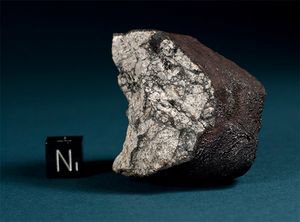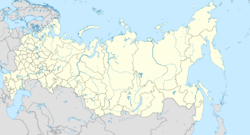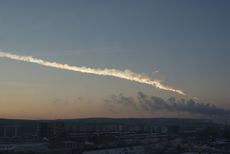نيزك چلیابینسك
(image link) Meteor fireball seen from Kamensk-Uralsky where it was still dawn, in an oblast north of Chelyabinsk | |
| التاريخ | 15 فبراير 2013 |
|---|---|
| الوقت | 09:20 YEKT (UTC+06:00) |
| الموقع | |
| الإحداثيات | 55°09′00″N 61°24′36″E / 55.150°N 61.410°E[1] |
| ويُعرف أيضاً بـ | Chelyabinsk meteorite[2] |
| السبب | Meteor air burst |
| اصابات غير قاتلة | 1,491[3] |
| أضرار مادية | Over 7,200[4] damaged buildings, collapsed factory roof, shattered windows |
في 15 فبراير 2013، سقط نيزك مصحوب بشهب عديدة على اوبلاست چلیابنسك، ولا توجد معطيات عن سقوط ضحايا بشرية، ولكن المعلومات تشير إلى أن حوالي ألف شخص قصدوا المستشفيات العامة لتلقي العلاج من اصابات نتجت عن تحطم النوافذ الزجاجية ببعض المباني القريبة من منطقة السقوط.وبلغ عدد المباني المتضررة من سقوط النيزك زهاء 3 آلاف مبنى. وكان النيزك قد سقط وتخلل سقوطه سطوع نور، وهناك معلومات تفيد بأن احتراق الينزك وتفتته وقع على ارتفاع 10 ألاف متر. أدى الحادث إلى تحطم زجاج بعض المنازل في القرى والبلدات القريبة.
. . . . . . . . . . . . . . . . . . . . . . . . . . . . . . . . . . . . . . . . . . . . . . . . . . . . . . . . . . . . . . . . . . . . . . . . . . . . . . . . . . . . . . . . . . . . . . . . . . . . . . . . . . . . . . . . . . . . . . . . . . . . . . . . . . . . . . . . . . . . . . . . . . . . . . . . . . . . . . . . . . . . . . . .
التقارير الداخلية
ويقول العلماء، أن النيزك الذي سقط في اوبلاست چلیابنسك صغير جدا من حيث حجمه وطاقته، قياسا بنيزك تونگونسك الذي سقط عام 1908 في حوض نهر تونگوسكا في شرق سيبيريا الذي تراوحت قوته بموجب حسابات مختلفة بين 10 و40 ميگاطن من مادة التروتيل الشديدة الانفجار. أما النيزك الذي سقط في 15 فبراير فقوته أقل من ذلك بكثير.[5]
وحسب المؤشرات، فان النيزك الذي سقط في أراضي اوبلاست چلیابینسك هو حجري أو حجري – حديدي. وبعد أن حلق فوق المواقع السكنية، سقط في بحيرة چيباركول على بعد كيلومتر واحد من المدينة التي تحمل الاسم نفسه.
دخول الغلاف الجوي


حقل التناثر

الجرحى والخسائر
ردود الفعل
التغطية الإعلامية
| Meteor Air Burst | |
متغيرات المسار المداري
| المصدر | Q | q | a | e | i | Ω | ω |
|---|---|---|---|---|---|---|---|
| AU | (°) | ||||||
| Lyytinen via Hankey; AMS[6] | 2.53 | 0.80 | 1.66 | 0.52 | 4.05° | 326.43° | 116.0° |
| Zuluaga, Ferrin; ArXiv[7] | 2.64 | 0.82 | 1.73 | 0.51 | 3.45° | 326.70° | 120.6° |
| Borovicka, et al.; IAU 3423[8] | 2.33 | 0.77 | 1.55 | 0.50 | 3.6° | 326.41° | 109.7° |
| Zuluaga, Ferrin, Geens; arXiv[9] | 1.816 | 0.716 | 1.26 ± 0.05 |
0.44 ± 0.03 |
2.984° | 326.5° ± 0.3° |
95.5° ± 2° |
| Chodas, Chesley; JPL via Sky and Telescope[10] | 2.78 | 0.75 | 1.73 | 0.57 | 4.2° | ||
| Insan[11] | 1.5 | 0.5 | 3° | ||||
| Proud; GPL[12] | 2.23 | 0.71 | 1.47 | 0.52 | 4.61° | 326.53° | 96.58° |
| de la Fuente Marcos; MNRAS: Letters[13] | 2.48 | 0.76 | 1.62 | 0.53 | 3.82° | 326.41° | 109.44° |
Ω = Ascending node longitude, ω = Argument of perihelion
. . . . . . . . . . . . . . . . . . . . . . . . . . . . . . . . . . . . . . . . . . . . . . . . . . . . . . . . . . . . . . . . . . . . . . . . . . . . . . . . . . . . . . . . . . . . . . . . . . . . . . . . . . . . . . . . . . . . . . . . . . . . . . . . . . . . . . . . . . . . . . . . . . . . . . . . . . . . . . . . . . . . . . . .
اندفاع الشظايا
Coincidental asteroid approach
انظر أيضاً
مرئيات
| ڤيديو لاختفاء آثار نيزك چلیابینسك بعد ثلاثة أشهر من سقوطه. |
الهوامش
المصادر
- ^ خطأ استشهاد: وسم
<ref>غير صحيح؛ لا نص تم توفيره للمراجع المسماةJPL20130301 - ^ "Chelyabinsk". Meteoritical Bulletin Database. The Meteoritical Society. Archived from the original on 2013-06-03.
{{cite web}}: Unknown parameter|deadurl=ignored (|url-status=suggested) (help) - ^ "Число пострадавших при падении метеорита приблизилось к 1500" (in Russian). РосБизнесКонсалтинг. 18 February 2013. Archived from the original on 2013-05-02.
{{cite web}}: Unknown parameter|deadurl=ignored (|url-status=suggested) (help); Unknown parameter|trans_title=ignored (|trans-title=suggested) (help)CS1 maint: unrecognized language (link) - ^ خطأ استشهاد: وسم
<ref>غير صحيح؛ لا نص تم توفيره للمراجع المسماةRBTH-23513 - ^ "إصابة حوالي ألف شخص نتيجة سقوط نيزك بمنطقة الأورال الروسية". روسيا اليوم. 2013-02-15. Retrieved 2013-02-16.
- ^ خطأ استشهاد: وسم
<ref>غير صحيح؛ لا نص تم توفيره للمراجع المسماةAMS - ^ خطأ استشهاد: وسم
<ref>غير صحيح؛ لا نص تم توفيره للمراجع المسماةZuluaga2013 - ^ خطأ استشهاد: وسم
<ref>غير صحيح؛ لا نص تم توفيره للمراجع المسماةIAUCBET3423 - ^ قالب:Cite arxiv
- ^ Beatty, Kelly (6 March 2013). "Update on Russia's Mega-Meteor". Sky and Telescope. Archived from the original on 2013-06-23.
{{cite web}}: Unknown parameter|deadurl=ignored (|url-status=suggested) (help) - ^ Вибе, Дмитрий (25 March 2013). "Семинар по Челябинскому метеориту: российская наука выдала "официальную" информацию" (in Russian). Компьютерра. Archived from the original on 2013-06-23.
{{cite web}}: Unknown parameter|deadurl=ignored (|url-status=suggested) (help); Unknown parameter|trans_title=ignored (|trans-title=suggested) (help)CS1 maint: unrecognized language (link) - ^ خطأ استشهاد: وسم
<ref>غير صحيح؛ لا نص تم توفيره للمراجع المسماةGRL_50660 - ^ خطأ استشهاد: وسم
<ref>غير صحيح؛ لا نص تم توفيره للمراجع المسماةRAS_slt103
قراءات إضافية
- Yau, Kevin; Weissman, Paul; Yeomans, Donald (1994). "Meteorite falls in China and some related human casualty events". Meteoritics. 29 (6): 864-871. Bibcode:1994Metic..29..864Y. ISSN 0026-1114.
- Synopsis: "A calculation based on the number of casualty events in the Chinese meteorite records suggests that the probability of a meteorite striking a human is far greater than previous estimates."
- Proud, S. R. (2013). "Reconstructing the orbit of the Chelyabinsk meteor using satellite observations". Geophysical Research Letters. 40 (13): 3351–3355. Bibcode:2013GeoRL..40.3351P. doi:10.1002/grl.50660.
- Tauzin, B.; Debayle, E.; Quantin, C.; Coltice, N. (2013). "Seismoacoustic coupling induced by the breakup of the 15 February 2013 Chelyabinsk meteor". Geophysical Research Letters. 40 (14): 3522. doi:10.1002/grl.50683.
- Gorkavyi, N.; Rault, D. F.; Newman, P. A.; Da Silva, A. M.; Dudorov, A. E. (2013). "New stratospheric dust belt due to the Chelyabinsk bolide". Geophysical Research Letters. doi:10.1002/grl.50788.
- Le Pichon, A.; Ceranna, L.; Pilger, C.; Mialle, P.; Brown, D.; Herry, P.; Brachet, N. (2013). "The 2013 Russian fireball largest ever detected by CTBTO infrasound sensors". Geophysical Research Letters. 40 (14): 3732. doi:10.1002/grl.50619.
- de la Fuente Marcos, C.; de la Fuente Marcos, R. (2013). "The Chelyabinsk superbolide: a fragment of asteroid 2011 EO40?". Monthly Notices of the Royal Astronomical Society Letters. arXiv:1307.7918. doi:10.1093/mnrasl/slt103.
وصلات خارجية
- "Meteor vapour trail from space". Image captured by EUMETSAT satellite.
- "Satellite views of meteor vapor trail over Russia". CIMSS Satellite Blog.
- "Russia Meteor Not Linked to Asteroid Flyby". NASA.
- "Метеоритный удар по Челябинску". Chelyabinsk website (in Russian).
{{cite web}}: Unknown parameter|trans_title=ignored (|trans-title=suggested) (help)CS1 maint: unrecognized language (link) - "Meteor Strike". NOVA documentary broadcast, 53 minutes, aired 27 March 2013. PBS.
Includes extensive scientific analysis of the worldwide infrasound monitoring network data from which the megaton energy estimates were made.
- Pages using gadget WikiMiniAtlas
- CS1 errors: unsupported parameter
- Coordinates on Wikidata
- Pages using div col with unknown parameters
- 2013 في روسيا
- 2013 في العلوم
- كوارث طبيعية في 2013
- اوبلاست چليابنسك
- حوادث ارتطام
- اوبلاست كورگان
- نيازك
- كوارث طبيعية في روسيا
- اوبلاست سڤردلوڤسك
- اوبلاست تيومن
- نيازك عثر عليها في روسيا
- انفجارات في روسيا
- انفجارات القرن 21
- سقوط نيازك










